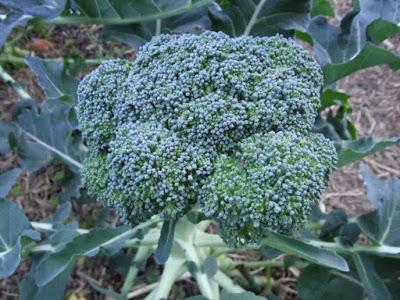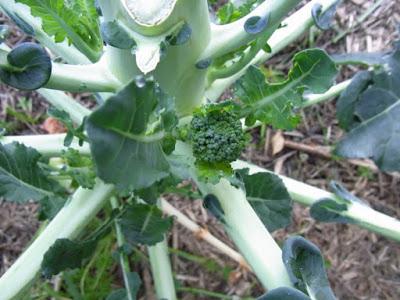Broccoli is one of those vegetables that I have to admit I cannot ever get all that excited about. I don't mind eating it; in fact we eat broccoli at least once every week, it's a routine part of our diet. As for growing it, it's similarly honest and reliable, not hard to grow, but while I was harvesting another head to take back to the kitchen, I finally found something to admire about broccoli: it's good value for money.
Now, this time I am only growing my own broccoli because I had bought a punnet of six seedlings for my mother-in-law Val's garden, but she had room only for three ... and so I had three left over. So "waste-not, want-not" came into operation and I planted the three remaining seedlings here in our garden a few months ago, and over the last week or two have begun harvesting some.
 Exhibit A: a completely ordinary head of broccoli, not quite at full harvestable size, but no doubt ready to go by the next weekend.
Exhibit A: a completely ordinary head of broccoli, not quite at full harvestable size, but no doubt ready to go by the next weekend. Exhibit B: sprouting from the lower levels of an already-harvested broccoli plant, side shoots forming smaller broccoli heads. That's my excitement, folks. It ain't all over when you cut off the mega-head of broccoli at the top of the plant. Give your broccoli a week or two more, another liquid feed, and production resumes, albeit on a smaller scale. Still delicious.
Exhibit B: sprouting from the lower levels of an already-harvested broccoli plant, side shoots forming smaller broccoli heads. That's my excitement, folks. It ain't all over when you cut off the mega-head of broccoli at the top of the plant. Give your broccoli a week or two more, another liquid feed, and production resumes, albeit on a smaller scale. Still delicious.The one thing about this variety of broccoli that I planted is that it was labelled "mini broccoli". Now that it's producing heads it looks like a completely normal broccoli plant to me, there's nothing mini about it.
But that happened a few years ago when I planted supposed "mini" cauliflower, and it produced completely normal cauliflowers for me on gorgeous but large plants. So, provided you're not fooled by the misleading plant label, these minis are still a very good backyard vegie to grow, but they do need a fair bit of space.
Broccoli loves sunshine, the cooler months, liquid feeds, and a soil rich in compost and organic manure. Just remember to leave the plants alone after the initial harvest, and it will give you more in due course.
